 This review is part of the Cameras of the Dead series which I have been publishing every year on Halloween and “Halfway to” Halloween, featuring three cameras that I’ve wanted to review that either didn’t work, or was otherwise unable to shoot.
This review is part of the Cameras of the Dead series which I have been publishing every year on Halloween and “Halfway to” Halloween, featuring three cameras that I’ve wanted to review that either didn’t work, or was otherwise unable to shoot.
I am republishing each of those individual reviews this October in anticipation of this Halloween’s Cameras of the Dead post as a way to revisit the cameras of the past that allows them to be properly indexed on the site.
This is a Perfex One-O-Two 35mm rangefinder camera, made by the Candid Camera Corporation of America out of Chicago, IL around 1948. It was one of eight different Perfex models made by the company from 1938 – 1950. Originally featuring a cloth focal plane shutter prior to the war, the Perfex One-O-One and One-O-Two models switched to a more basic, but also more reliable Wollensak leaf shutter mounted inside of a fixed f/4.5 or f/3.5 lens. It was a mild success and represented a very short period of popularity of American made rangefinder cameras, but by 1950, significant competition from Japan and Germany forced the company into bankruptcy.
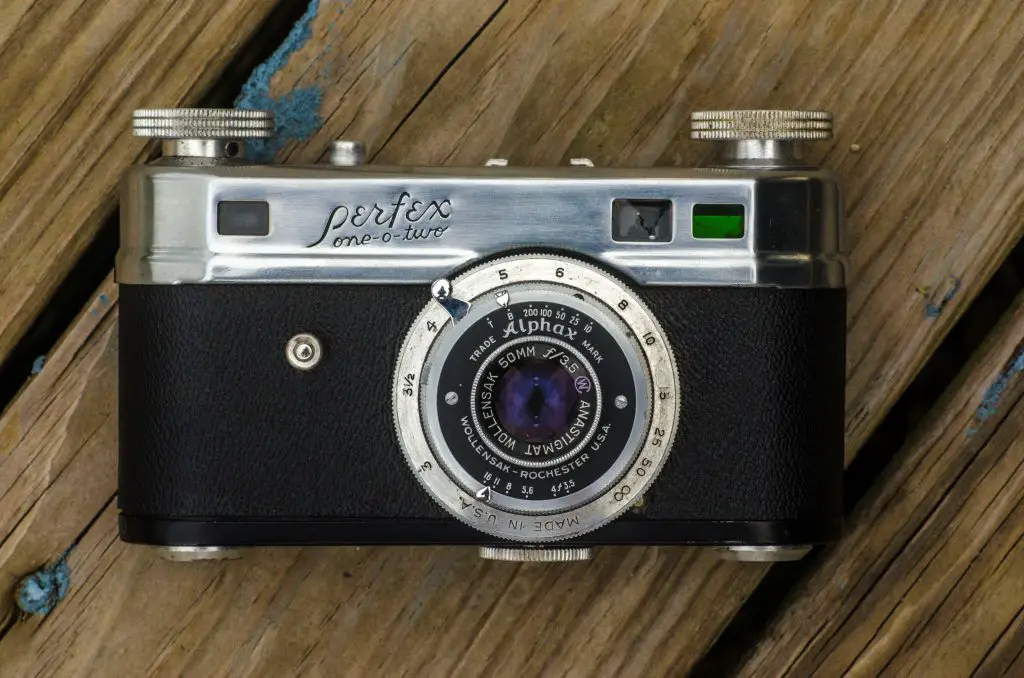 Film Type: 135 (35mm)
Film Type: 135 (35mm)
Lens: 50mm Wollensak Anastigmat f/3.5 coated 3-elements
Focus: 3 feet to Infinity
Viewfinder: Separate Split Image Rangefinder and Viewfinder
Shutter: Wollensak Alphax Leaf
Speeds: T, B, 1/10 – 1/200
Exposure Meter: None
Battery: None
Flash Mount: M-sync port on Shutter, and Hot shoe on camera top plate
Manual (similar model): http://www.cameramanuals.org/pdf_files/perfex_fifty-five.pdf
My Thoughts
As an American, I can definitely see the flaws in my country’s history, and the flaws that still plague us today. America is not perfect, but it is a good country and I am glad I was born here. I have always been fascinated with world history, but living in a country who was created as a result of a bunch of guys saying “F*** YOU”, there’s that sense of rebellious underdog patriotism that I think many Americans have.
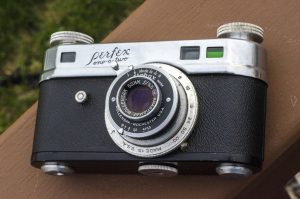
American patriotism was at an all time high in the years following World War II. Although Germany was the undisputed champion of cameras and all photographic equipment, there was a strong demand for new models at this time, and the idea of an American made camera to compete with the Germans was very appealing. As a result, many American companies appeared out of nowhere right after the war to produce their own models, which they hoped to fill the demand for such products.
Sure, we already had Argus, Ciro, Universal, and Kodak from before the war, but all of a sudden, companies like Chicago based Candid Camera Corporation, Minneapolis based Clarus, and Craftex out of Hollywood, CA all appeared seemingly out of nowhere. At best, you could say that some of the models made by these companies were ambitious, but most were poorly designed cheap models that were rushed to the market with simple shutters and basic lenses.
Technically, the Perfex was released prior to the start of the war, but I think it’s greatest success was right after the war ended due to the huge demand for American made products. There were a total of 8 different Perfex models, the original models featured a proprietary interchangeable lens mount, and a cloth focal plane shutter. Claiming to be the first camera with a focal plane shutter with a flash synchronized hot shoe (Universal also made this claim with the Univex Mercury although it had a unique shutter), it was equipped with a variety of lenses made by Wollensak out of Rochester, NY. The mere presence of so many variants of the Perfex suggests that it sold reasonably well, but could not find any information regarding production numbers over it’s 12 or so year production run.
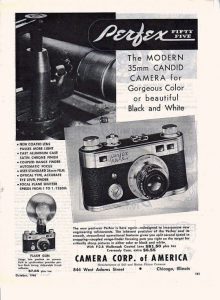
After World War II, only one pre-war model was still in production, the top of the line Perfex Fifty-Five. Selling in 1946 with a Wollensak f/2.8 lens for $81.50, it wasn’t exactly cheap. When adjusted for inflation, that’s equivalent to $1009 today. While reasonably nice on paper, the Perfex cameras were not built to the same precision as German models. The body was a solid piece of cast metal with a chrome finish. The shutter was not reliable, and although it boasted a top speed of 1/1250, there were claims that it was never accurate from the start. Like another American camera, the Clarus MS-35, the Perfex series of cameras suffered a poor reputation as being unreliable and inferior to their German competition.
As a result, in 1948 the Fifty-Five was replaced with 3 new models, the Deluxe, One-O-One, and One-O-Two. The Deluxe had the same focal plane shutter and interchangeable lens mount as the Fifty-Five, but the other two models were lower cost models with Wollensak Alphax leaf shutters and a fixed lens mount. These changes allowed for the Perfex to be sold at a lower cost, and the well designed leaf shutter proved to be more reliable. It would seem though, that the Perfex’s reputation as an unreliable camera, plus the rise of the Japanese camera market killed any demand for the camera, and production ceased in 1950.
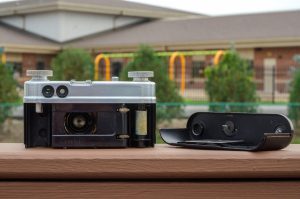
One year prior to the collapse of the Candid Camera Corporation, a revised model called the Cee-ay-35 was created with a more sophisticated body design, but it was too little too late. The design of the Cee-ay 35 was sold to fellow American company, Ciro, who rebadged the camera as the Ciro 35 and continued to make it for a few more years as an inexpensive American rangefinder.
I don’t know that today anyone collects Perfex cameras other than those like me who have a bit of American patriotism who want to revisit what the American camera industry was like after World War II. When I got this camera last year, I had the intent to do an “American Face-Off” article and compare it to other American cameras like the Argus C3, Clarus MS-35, and whatever else I could find. Although the Perfex One-O-Two that I picked up was in cosmetically very nice condition, it was completely inoperable. The shutter wouldn’t fire and someone previously had disassembled the lens and did not put it back together properly as the focus would just spin freely without engaging the rangefinder.
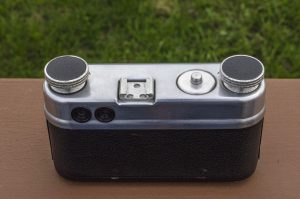
Further adding to my underwhelming opinion of the camera, the build quality of this camera feels cheap. Usually we tend to associate cheap things as being lightweight, but the Perfex is the opposite, it is extremely heavy, almost to the point of being comical. It literally feels like a lead weight in your hands. Where most heavy cameras have a feeling of purposeful precision, the Perfex feels like a clumsy dumbbell and where many metal camera bodies can feel elegant and cool, the solid metal panels on this camera just feel cold like a cannonball in winter. The viewfinders are small and dim, and the lack of a functioning shutter just turned me off from any attempt to salvage it.
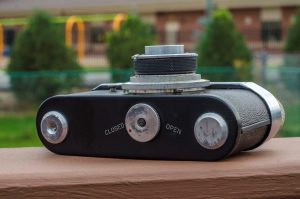
In reality, this is a pretty basic camera, and I do have some experience restoring Alphax shutters like the ones on my Argoflex EF, and Ciro-Flex. There is a chance I could revive this camera, but I’ve had it for nearly a year, and not once have I ever been excited about giving it a shot. This thing has literally just sat in a box for months, largely forgotten. When I was planning this article, this was actually the last camera I thought to include because frankly, I had forgotten about it. Who knows, maybe that’s the exact reason why I SHOULD revive it. If I could get this thing working and manage to get some shots from it, it could very well be my most underwhelming camera ever, and who knows, that might make for an interesting article!
For now, this remains a “Camera of the Dead” and I am happy to share what little I know about it with you!
Related Posts You Might Enjoy
External Links
http://camera-wiki.org/wiki/Perfex
http://historiccamera.com/cgi-bin/librarium2/pm.cgi?action=app_display&app=datasheet&app_id=1801

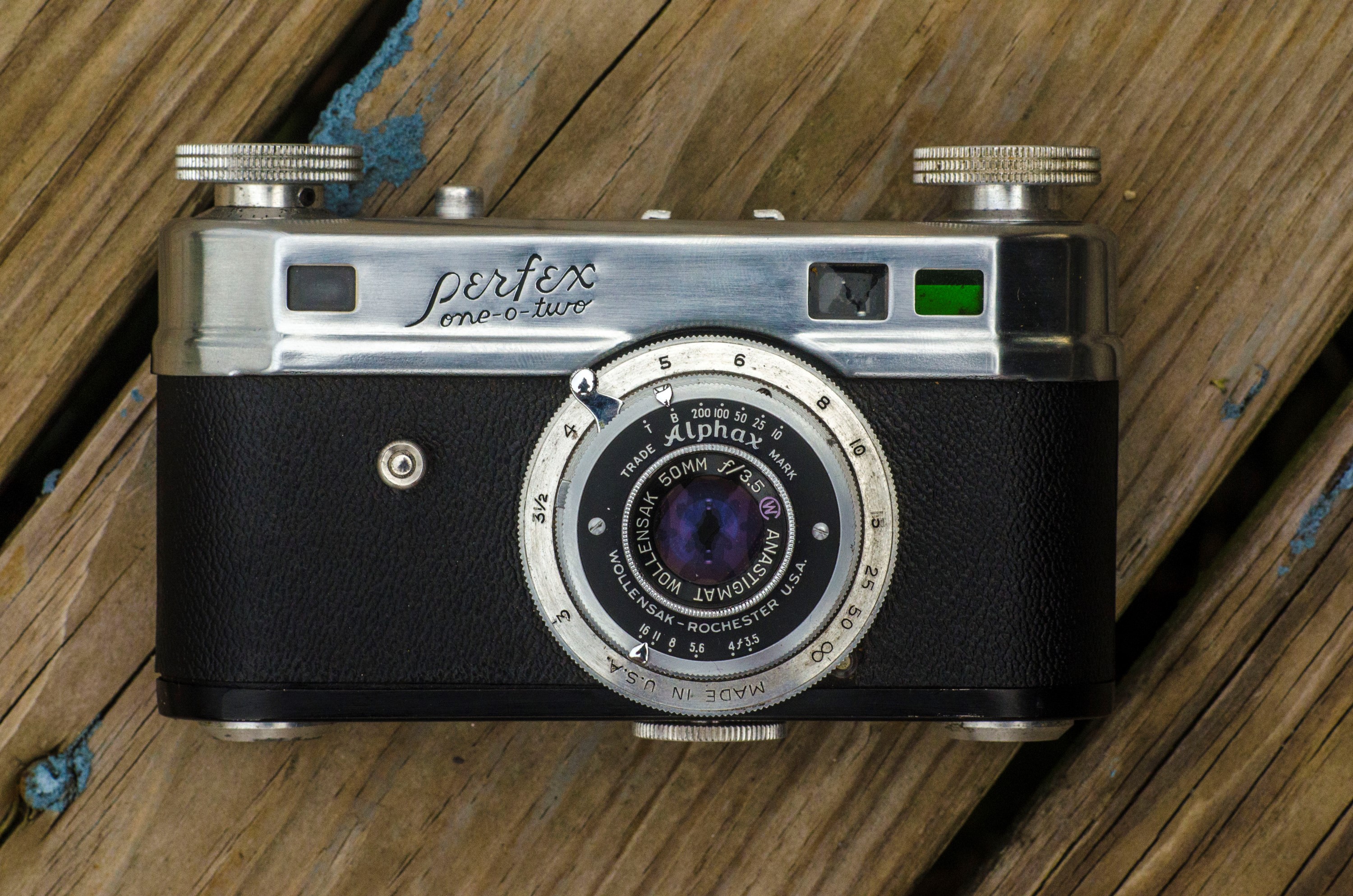
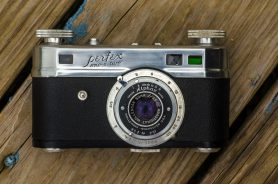
Very informative and interesting – I am thinking of acquiring a One-O-Two. Two questions if I may : might you happen to know where I could find a manual? And with this camera design and this shutter, can you tell me if there is a specific order “wind on film then adjust speed” or vice versa?
I already have a 44 which I like a lot but which despairingly records dark vertical stripes on each negative. Shutter issue I think.
Regards from Germany,
John
Hi John. The One-O-Two uses a basic Wollensak Alphax shutter, which does not have any specific steps for setting shutter speeds, just turn the dial to whatever you want. This can be done before or after advancing the film and the shutter is not at all coupled to the film transport. The Alphax shutter uses a self-cocking design that cocks and fires the shutter all in one motion, so you’re free to change it whenever you want! Good luck with the camera. Although mine didn’t work, I’ve shot many other cameras with Wollensak lenses and they almost always produce very nice images.